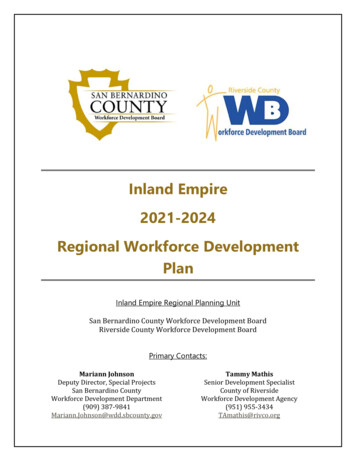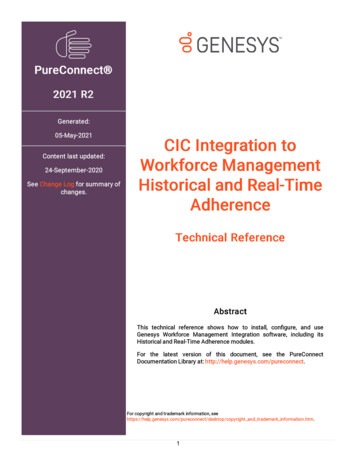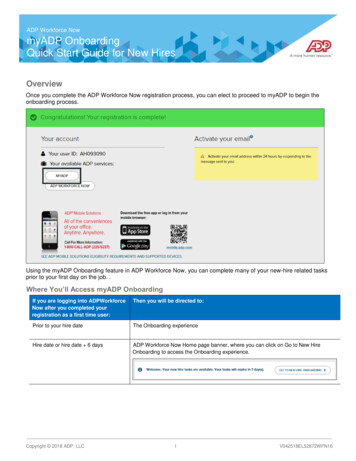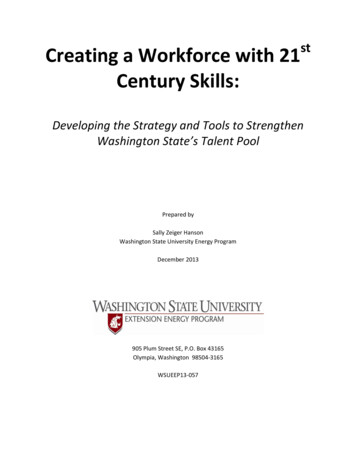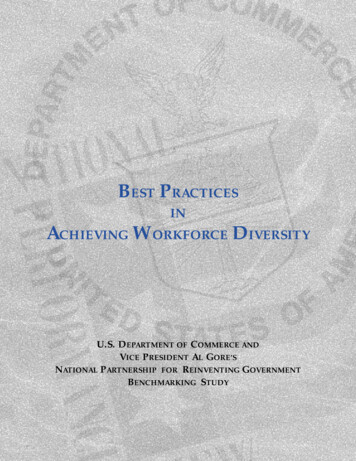
Transcription
BEST PRACTICESINACHIEVING WORKFORCE DIVERSITYU.S. DEPARTMENT OF COMMERCE ANDVICE PRESIDENT AL GORE’SNATIONAL PARTNERSHIP FOR REINVENTING GOVERNMENTBENCHMARKING STUDY
T ABLE OF C ONTENTSBENCHMARKING STUDY PARTNERS . . . . . . . . . . . . . . . . . . . . . . . . . . . . . . . . . . . . . . . . . . . . . . . . . . . . . . . ivACKNOWLEDGMENTS. vEXECUTIVE SUMMARY. 1CHAPTER 1: INTRODUCTION . . . . . . . . . . . . . . . . . . . . . . . . . . . . . . . . . . . . . . . . . . . . . . . . . . . . . . . . . . . . . 3CHAPTER 2: LEADERSHIP COMMITMENT . . . . . . . . . . . . . . . . . . . . . . . . . . . . . . . . . . . . . . . . . . . . . . . . . . . 5CHAPTER 3: STRATEGIC PLANNING. 7CHAPTER 4: EMPLOYEE INVOLVEMENT. . . . . . . . . . . . . . . . . . . . . . . . . . . . . . . . . . . . . . . . . . . . . . . . . . . 11APPENDICESA. BENCHMARKING AGENCY PARTICIPANTS . . . . . . . . . . . . . . . . . . . . . . . . . . . . . . . . . . . . . . . . . . . . A1B. TELEPHONE SURVEY . . . . . . . . . . . . . . . . . . . . . . . . . . . . . . . . . . . . . . . . . . . . . . . . . . . . . . . . . . . . . B1C. SCORE CARD . . . . . . . . . . . . . . . . . . . . . . . . . . . . . . . . . . . . . . . . . . . . . . . . . . . . . . . . . . . . . . . . . . . C1D. SITE VISIT GUIDE . . . . . . . . . . . . . . . . . . . . . . . . . . . . . . . . . . . . . . . . . . . . . . . . . . . . . . . . . . . . . . . D1
B ENCHMARKING S TUDY P ARTNERSCoors Brewing CompanyGolden, ColoradoDaimlerChryslerAuburn Hills, MichiganEastman KodakRochester, New YorkFannie MaeWashington, DCThe PrudentialInsurance Company of AmericaNewark, New JerseyThe Seattle TimesSeattle, WashingtonSempra EnergySan Diego, CaliforniaUnited States Coast GuardWashington, DCXeroxRochester, New York
ACKNOWLEDGMENTSSTUDY SPONSORSROBERT L. MALLETTDEPUTY SECRETARYU. S. DEPARTMENT OF COMMERCEMORLEY WINOGRADSENIOR POLICY ADVISOR TO THE VICE PRESIDENTDIRECTOR, NATIONAL PARTNERSHIP FOR REINVENTINGGOVERNMENT (NPR)STUDY DIRECTORWILETT BUNTONDIRECTORNPR DIVERSITY TASK FORCEU.S. DEPARTMENT OF THE ARMYSTUDY ADVISORSCAROL HAYASHIDADEPUTY DIRECTORNPR DIVERSITY TASK FORCEU.S. DEPARTMENT OF COMMERCEROB SADLERATTORNEYNPR DIVERSITY TASK FORCEU.S. DEPARTMENT OF COMMERCERAJ K. GUPTAATTORNEYNPR DIVERSITY TASK FORCEU.S. EQUAL EMPLOYMENT OPPORTUNITY COMMISSIONSTUDY TEAM LEADERSORELIOUS WALKER, PRINCIPALU.S. DEPARTMENT OF TREASURYDAVID BENTONU.S. DEPARTMENT OF TRANSPORTATIONThe Benchmarking Team thanks the corporate and government partners who willingly shared their experiences and bestpractices with us. Special thanks to Linda J. Bilmes, Chief Financial Officer and Assistant Secretary for Administration,United States Department of Commerce; John J. Phelan III, Director, Office of Management and Organization, UnitedStates Department of Commerce; Lisa Mallory, Deputy Director, National Partnership for Reinventing Government; and,Tom Kowalczyk, Senior Engineer, Naval Undersea Warfare Center Division Newport.
Executive SummaryBest Practices in Achieving Workforce DiversityExecutive SummaryDiversity Affects the WorldAdvances in technology and the advent of aglobal economy bring the people of the worldcloser together than ever before. Given this fact,businesses, educational systems and other entitiesare investigating ways to better serve theirconstituents. This includes being able to attractand retain the best and most qualified workers.Organizations that can develop and employ thenecessary policies and procedures to do this willmaintain a competitive advantage among theircounterparts and increase their effectiveness. Theprivate sector competitive model may notsquarely fit Federal departments and agencies,given the lack of profit motive as the reason fortheir existence. Yet, Federal organizations mustcompete to recruit and retain the best talent ifthey hope to achieve their bottom line, theirstatutory missions.The changing demographics of our nation alsoaffect the nation’s businesses and in turn thenation’s economy. For our government andbusinesses to continue to be effective and motivatecitizens to contribute to building theseinstitutions, our leaders must recognize andcapitalize upon the diversity of the nation.Why is this important?To achieve success and maintain a competitiveadvantage, we must be able to draw on the mostimportant resource – the skills of the workforce.With the increasing richness of diversity in theworld and in the workforce, we need to expandour outlook and use creative strategies to besuccessful. Employees can provide thisresource. This study identifies best practicesthat work in organizations that are doing justthat. These practices can be adopted in anyworkplace.Why should we pay attention?Our partners have created communities ofpractice that achieve and value workforcediversity within their organizations. Thesepractices reflect our partners’ understandingthat valuing and recognizing diversity isimperative in order to maintain a competitiveadvantage. They know that using thesepractices enhances productivity, effectiveness,and sustained competitiveness.How is this different?Frequently, diversity is viewed in a limitedfashion, primarily addressing issues of race,ethnic or gender differences, and linked to thelaws providing protected status to certaingroups. We have used a very broad definitionof diversity, to encompass most characteristicsthat individuals possess that affect the way theythink and do things. This is critical. Thisstudy describes tested ways to draw on all thevaried skills of our workforce.What did we learn?This study emphasizes the most valuableinformation that the best practices organizationshave to offer. Our critical findings focus on thefollowing information because we can use it tofurther and strengthen the U.S. government’sefforts to achieve diversity in the workplace. Organizations Benefit from DiversityOrganizations that promote and achieve adiverse workplace will attract and retainquality employees and increase customerloyalty. For public organizations, it alsotranslates into effective delivery of essentialservices to communities with diverse needs. Leaders and Managers are Responsible forDiversityLeaders and managers within organizationsare primarily responsible for the success ofdiversity policies because they must ensurethat the policies are effective.Our success as aglobal companyis a direct resultof our diverseand talentedworkforce. Ourability to developnew consumerinsights andideas and toexecute in asuperior wayacross the worldis the bestpossibletestimony to thepower ofdiversity anyorganizationcould ever have.John Pepper, CEO,Procter & Gamble
Executive SummaryBest Practices in Achieving Workforce Diversity Leaders and Managers must Create aStrategic Plan to Develop DiversityInitiatives Throughout the OrganizationLeaders and managers within organizations mustincorporate diversity policies into every aspect ofthe organization’s functions and purpose. Employees’ Views and Involvement are Keyto the Success of Diversity InitiativesOrganizations must view employeeparticipation as a necessary part of thediversity initiative, in order to develop andmaintain effective diversity policies.The leaders of the best practices organizationsunderstand that they must support theiremployees in learning how to effectivelyinteract with and manage people in a diverseworkplace. They recognize that they shouldencourage employees to continue to learnnew skills in dealing with and managingpeople. They also recognize the impact thatdiverse clients will have upon the success orfailure of an organization, as businesses mustcompete to satisfy these clients.Our Key FindingA key finding of this report is that diversityneeds to be defined broadly and shouldencompass a wide range of initiatives that meetthe changing needs of customers and workers.Leaders and employees should take active rolesin implementing these diversity processeswhich, in order to succeed, should be fullyaligned with core organizational goals andobjectives. The findings in this report illustratethat the benefits of diversity are for everyone.Diversity is more than a moral imperative; it isa global necessity. Moreover, diversity is anessential component of any civil society.
IntroductionBest Practices in Achieving Workforce Diversityhapter 1: IntroductionToday’s managers are responsible for bothleading employees and responding to the needsof customers who are more ethnically andculturally diverse, older, and in greater need ofchild and elder care. Leaders in both the publicand the private sectors are focusing moreattention on the issue of diversity. Whether thegoal is to be an employer of choice, to provideexcellent customer service, or to maintain acompetitive edge, diversity is increasinglyrecognized and utilized as an importantorganizational resource.What is Diversity?One of the major stumbling blocks indiscussions surrounding diversity is its verydefinition. For our purposes, we use thefollowing definition of diversity: "Diversityincludes all characteristics and experiences thatdefine each of us as individuals."1 A commonmisconception about diversity is that onlycertain persons or groups are included under itsumbrella, when in fact, exactly the opposite istrue. Diversity includes the entire spectrum ofprimary dimensions of an individual, includingRace, Ethnicity, Gender, Age, Religion,Disability, and Sexual orientation (referred to bythe Diversity Task Force as “REGARDS”).Secondary dimensions commonly include:communication style, work style, organizationalrole/level, economic status, and geographicorigin (e.g., East, Midwest, South). It is asimple fact that each of us possesses uniquequalities along each of these dimensions.Experience and recent research indicate thatwhen recognized and valued, diversity enhancesindividual productivity, organizationaleffectiveness, and sustained competitiveness.2In order "to maximize the utilization of itshuman capital, organizations must go beyondmerely creating a more diverse workplace.Once there, the value of having diverseemployees must be recognized."3 Now is thetime to move beyond viewing diversity asmerely the numerical representation of certaingroups. It is time for a systematic application ofdiversity concepts to the business of theorganization. As one benchmarking partnerstated, "We view diversity as something morethan a moral imperative or a businessnecessity—we see it as a business opportunity."Aligning diversity with the mission and businessof the organization increases employeesatisfaction and retention; improvescompetitiveness and productivity; increasesresponsiveness; and adds value to the customer.Scope of the StudyThe United States Department of Commerceand Vice President Al Gore’s NationalPartnership for Reinventing Government(NPR) sponsored this benchmarking study.The study identifies best practices used byleading organizations to achieve workforcediversity. The study team identified thefollowing critical success factors to evaluate bestpractices:1. Leadership and managementcommitment;2. Employee involvement;3. Strategic planning;4. Sustained investment;5. Diversity indicators;6. Accountability, measurement, andevaluation; and7. Linkage to organizational goals andobjectives.The practices that are included in this report arenot identified by specific organization in orderto preserve the partners’ confidentiality.The study team reviewed a wide range ofdiversity literature and identified over 600companies and organizations—both public andprivate—which were recognized for their effortsin achieving workforce diversity. The study teamconducted an additional screening procedure toidentify organizations whose exemplary practicesin achieving workforce diversity were truly"world class" based on the identified criticalsuccess factors. As a result, 65 organizations wereselected for more detailed analysis.There were neverin the world twoopinions alike;anymore thantwo hairs ortwo grains. Themost universalquality isdiversity.Michel de Montaigne,French Essayist1The working definition of diversity, asdeveloped and used by Vice President AlGore’s National Partnership forReinventing Government (NPR)Diversity Task Force, based on acomprehensive review of diversityliterature.2See, e.g., Taylor Cox, Jr., CulturalDiversity in Organizations (SanFrancisco: Berrett-Koehler Publishers),1994, pp. 19-40; Ann Morrison, TheNew Leaders: Guidelines on LeadershipDiversity in America (San Francisco: JoseyBass Publishers),1992, pp. 18-28.3J. Renae Norton and RonaldE. Fox, The Change Equation(Washington, DC: AmericanPsychological Association),1997, p. 80.
IntroductionBest Practices in Achieving Workforce DiversityThe study team developed a telephone surveythat was administered to representatives of theseorganizations to gain additional insights ontheir current diversity practices. Based onsurvey results and availability considerations,nine benchmarking partners were ultimatelyselected for on-site visits. More than half ofthese partners have been recently featured inFortune and Next Step magazine articleshighlighting their cutting-edge diversity bestpractices.4This report and other studies clearlydemonstrate that some organizations havesuccessfully implemented programs and policiesthat foster diversity and inclusiveness in the4See articles published in KeithEllison, "The Next Step Diversity 100,"Next Step (Philadelphia, Next StepEnterprises), Spring 1999, p. 34; EdwardRobinson and Jonathan Hickman, "TheDiversity Elite," Fortune (New York:Time, Inc.), July 1999, p. 62.See supra, footnote 2.5workplace.5 There are common themes andelements among the organizations that havecharted successful courses in this area. Throughbenchmarking studies such as this one, theFederal civilian sector—which employs over 1.6million persons—has the opportunity to learnmore about diversity from world classorganizations. The Department of Commerceand NPR recognize diversity as a key resourcein fulfilling the goal of making governmentmore efficient, productive and responsive to theAmerican citizenry. As a result, it is importantthat the Federal sector begin viewing diversity asa process which influences work climates,organizational effectiveness, customer service,and ultimately, the way we do business.
Leadership CommitmentBest Practices in Achieving Workforce Diversityhapter 2: Leadership CommitmentTaking Ownership andCommunicating the VisionThe degree to which our partners’ leaders areactively involved in implementing initiativesand risk taking distinguishes them from otherleaders. Managers manage change, but best-inclass leaders create change by inspiring theiremployees. Our partners champion diversity byinfusing it into all organizational processes andensuring that diversity is integrated into thecore values of the organization. They recognizediversity as an important goal, and position theresponsibility for diversity not merely withhuman resources departments or diversityoffices, but with top-level and senior executives.Our best-in-class leaders provide the visibilityand commit the time and resources to makediversity happen. In short, diversity is both atop priority and a personal responsibility forthese leaders. The top leader in one of our partnerorganizations personally leads the diversityefforts. He holds town hall meetings andregularly goes to the employee cafeteria tolisten and talk about diversity. A partner’s Chief Executive Officer requiresthe selection panel for key positions toidentify at least six persons qualified for theposition and has held up key selectionsbecause of the lack of diversity in applicantpools. The Chairman of the Board of one partnerorganization registered the corporation’sstatement of commitment to diversity withan external regulatory body. Changes to thiscommitment do not go unnoticed.The top leaders of our benchmarking partnerorganizations are all personally involved inhelping the boards of directors, employees,other stakeholders and their respectivecommunities understand that diversityinitiatives create fairer employment systems andbenefits for everyone. Equity and improved jobsatisfaction contribute to increased productivityand better customer service. One partner’s chiefexecutive stated that the diversity vision,mission and strategic direction needs to beconveyed by leaders "clearly, concisely andrepeatedly" to enhance awareness, promoteopen dialog, and remove barriers. Severalpartners stressed that effective communicationneeds to be multidirectional within and acrossdepartments.Creating a common frame of referenceestablishes a solid foundation upon which todiscuss diversity and develop action plans toeliminate biases and barriers. Our partners notethat there is no “one-size-fits-all” nor any“magic pill” to make diversity “happen.”However, some communication channelseffectively used by our partners to spread thediversity message include: policy statements,newsletters, meetings, speeches, trainingprograms,Web sites, and intranets. At one partner organization, top managementsupports the existence of a dedicated staff thatpromotes and oversees the infusion ofdiversity in its business lines and also designsactivities that promote and foster diversitythroughout the organization. A full time staffof six at the corporate level sends a messagethat there is top-level interest in diversity.This staff, located under the Vice Presidentfor Human Resources, is one level below theChief Executive Officer. To lead the company’s diversity efforts, onepartner created an Office of Diversity. TheVice President of Diversity, who reportsdirectly to the Vice Chair, heads the officeand has broad decision making authority.The Vice President of Diversity works closelywith the human resources division, theminority and women-owned businessprogram, and is a representative on everyboard and almost every committee in theorganization. When one partner organization recentlymerged with another company, the Chair,President, and Chief Executive Officer jointlysigned a diversity statement to keep diversityat the forefront. It states that, "DiversityWe must be thechange we wishto see in theworld.Mahatma Gandhi,India’s Nationalist Leader
Leadership CommitmentBest Practices in Achieving Workforce Diversitycreates value and is an integral part of beingthe premier global company." The statementoutlined their goals to: (1) ensure a workforcereflective of the global communities theyserve; and (2) create a culture that usesdiversity to its competitive advantage.Empowering Through LeadershipFor our benchmarking partners, diversity doesnot depend on a single leader because it hasbeen woven into the very fabric of theorganizations—woven into the way theseorganizations conduct business on a daily basis.This is because the leadership understands theimportance of employee involvement in thechange process. They also recognize that beingcompetitive in a global economy requires fullutilization of the skills and talents of allemployees to better serve their customers,increase employee satisfaction, and meet theneeds of diverse communities. One of ourpartners contends, "Success will only beachieved through inspired people operating inan environment based on mutual trust, respect,openness, candor, empowerment, teamwork,innovation, risk taking, integrity, andencouraging and valuing diversity." For one of our partners, Ten CoreCommitments represent the values thatdefine the spirit of the organization—diversity is one of these core commitments.The diversity commitment states: "We arecommitted to foster a diverse workforce andrecognize and value every individual’s uniqueskills and perspectives." These commitmentsare shared and reinforced on a daily basis. One partner has an upper-level leadershipteam that guides and evaluates the company’sprogress toward achieving its diversity goals.The team gains insights from an advisorygroup that represents eight employeecouncils. Each employee council has acorporate vice president as a sponsor. Thecouncils are inclusive—anyone who wants topromote cross-cultural communication isencouraged to become involved. To institutionalize diversity management atone partner organization, individuals who areseen as potential leadership successors areasked to become champions of diversitybefore assuming a leadership role. Once theybecome leaders they are already established asproponents for diversity. One partner recognizes the contributions ofits managers to advancing diversity. Forexample, in 1998 it created a Chief ExecutiveOfficer/Chief Operating Officer DiversityAward. This award recognizes managerswhose commitment to diversity makes themrole models for others. Such champions areused to share their experiences throughoutthe company to demonstrate the benefit ofdiversity to others.
Strategic PlanningBest Practices in Achieving Workforce Diversityhapter 3: Strategic PlanningLinking Diversity to Strategic PlansDiversity strategic planning focuses on creatingmeasurable ways diversity can support thestrategic direction, goals, and objectives of theorganization.6 Strategic level long-rangeplanning for diversity is a more recentdevelopment. Previously, diversity was not seenas an integral part of strategic planning.Diversity initiatives were often poorlyconceptualized, lacked specificity, and were notlinked to strategic organizational plans. Today’sleaders realize that in order to be effective,successful diversity planning must be alignedwith and provide support for strategic businessobjectives and operational decisions. One partner builds its diversity strategic planupon its core values: (1) respect for thedignity of the individual, (2) integrity, (3)trust, (4) credibility, (5) continuousimprovement, and (6) personal renewal. Thispartner has also set a specific "GlobalPerformance Expectation," which is to buildand manage a truly diverse workforce. Another partner uses a Balanced Workforce(BWF) Strategy, which is an all-encompassingstrategy. It guides the organization in avariety of situations and it covers all employeepopulations. It tracks employee populationsand sets 10-year goals and annual targets.The BWF makes managers accountable forupward mobility. When layoffs occur, theBWF ensures that members of one group arenot affected disproportionately compared tomembers of other groups. One partner has six strategic business planksthat are its business priorities to help itsustain consistent quality and earningsgrowth. The six planks concentrate onbaseline growth, incremental growth, productquality, distributor service, productivity gains,and people. The "People" plank is tocontinuously improve our business throughengaging and developing our people. Itfocuses on building skills, offering training,improving the work environment, andoffering market-competitive, performancebased compensation and benefits that alsomeet the changing needs of its workforce.The diversity mission is to drive towards theattainment of the “People” plank goals thatare to create an environment in which peoplefrom diverse backgrounds, styles, cultures,and functions all work together to assure thelong-term success of the company. One partner’s operating management and thehuman resources department jointlydeveloped a five-year diversity plan. Thisplan included a monitoring system tomeasure diversity representation by functionat all levels to: (1) ensure a balancedworkforce, and (2) strengthen theorganization’s ability to attract, hire, retain,and develop the most highly qualifiedemployees. Specific measures included in theplan are: positive responses to employeesurveys, positive articles in publications,reputation as an employer of choice,improved representation of diversity at alllevels, effective remedial action whenappropriate, awards, and other recognition. One partner’s strategic plan was designed toprovide a link between the vision for diversitymanagement and the actions required formaking it happen. One of the firstrequirements was to define diversity, anddiversity management. Once this wasaccomplished, the definitions were used toform the foundation of the organization’sdiversity policy, vision statement, andstrategic plan. The core elements of thestrategic plan are strategic goals andobjectives, a plan for conducting a culturalaudit, a training and education plan, a planfor recognizing diversity-relatedaccomplishments, and measures ofeffectiveness. The strategic plan alsoaddresses accountability for implementingdiversity initiatives. One partner’s strategic plan uses a four-stepapproach for establishing and implementingdiversity:When alignedwithorganizationalobjectives,diversity can bea powerfulcontributorto theorganization’scompetitiveadvantage.Dr. Edward E. Hubbard, Author,Measuring Diversity Results6Edward E. Hubbard, MeasuringDiversity Results (Petaluma, CA: GlobalInsights Publishing), 1997, Chapter 7.
Strategic PlanningBest Practices in Achieving Workforce Diversity1. Creating a strong foundation (values,philosophy, dedicated resources, andcommitment);2. Building a solid internal structure(initiatives to support and educateemployees);3. Building a solid external structure toinfuse diversity into the community; and4. Measuring the progress and results (goalsetting for all efforts). The components of one partner’s diversityplan include: (1) developing ongoingcommunication systems to create andreinforce the workplace diversity commitmentto all employees with an emphasis on why it isimportant and what it means to theorganization; (2) establishing departmentalaction plans to ensure the workforce reflectsthe diversity of the community; and (3)developing organization-wide assessment andevaluation systems to monitor diversityprogress throughout the organization.Additionally, training and empowermentinitiatives provide a foundation, for all levelsof the organization, to foster theaccomplishment of diversity goals. One partner conducted a study to developits diversity management policy. The workwas segmented into three phases: (1)Framework (diversity definition, policy andvision statement, best practices benchmarkingof other organizations and potentialapplication to the organization, and therationale for seeking a consultant’s assistance);(2) Strategic Plan (a plan of action forincorporating diversity management, a planfor conducting cultural audit, training plan,measures of effectiveness, accountabilitymethods, and rewards and recognition systemanalysis); and (3) Implementation(assessment of strengths and barriers in theculture, and a marketing strategy fordeploying diversity management). Another partner designed a strategic plan toprovide a link between the vision for diversitymanagement and the actions required forsuccess. The goals are to: (1) create a positiveenvironment (incorporate diversitymanagement training into all leadershiptraining programs); (2) conduct a culturalaudit and develop intervention strategies; (3)establish guidelines to define and addresssocial climate issues affecting personnel;(4) value all people (action plans to targetunderrepresentation, and implementaccountability measures into evaluations); and(5) promote individuals’ ability to reach theirfull potential (identify and groom highperforming individuals in underrepresentedgroups for upper-level positions, and makementor programs accessible to all).AccountabilityA key element to ensuring the success of anyorganizational initiative—especially diversityinitiatives—is accountability. Accountability isachieved by making the appropriate leadersresponsible for diversity by linking performanceevaluation elements and compensation to thesuccessful implementation and progress of theseinitiatives. Accountability helps to ensure that"everyone is on board" and actively engaged inthe diversity process. One partner makes use of "ConsequenceManagement." The program philosophymaintains that poor diversity managementadversely affects a manager’s ability tomanage. Promotion to the next level requires"competent" or "role model" assessment.One component for evaluating managementperformance is the ability to manage a diversegroup of employees. In 1996, one partner established a top-levelDiversity Steering and Assessment Team toguide and oversee diversity plans andprograms, and to ensure the level ofaccountability necessary in order to achievedesired results. Members include thePresident, Chief Financial Officer, SeniorVice President of Human Resources, andother corporate officers. They meet monthlyto discuss diversity progress and challenges.The team receives counsel from the DiversityAction and Advisory Group, comprised ofeight employee affinity groups. At one partner organization, recurringdiversity training is mandatory for allemployees, and business unit managers areheld accountable for timely attendance byboth management and non-managementemployees. To ensure managerialaccountability, the company reduces theoperating budget of a business unit by 1,000for each manager and 500 for eachemployee who fails to attend scheduledtraining without giving 48 hours advancenotice of cancellation. Last minute no shows
Strategic Planningare accordingly discouraged and managementis induced to treat diversity training with thesame seriousness as any other businessactivity. A director stated, " if you grabthem by their wallet, their hearts and mindswill follow." One partner organization has an open doorpolicy at all organizational levels. Anemployee must receive a response within 48hours, and if dissatisfied, the employee mayelevate the concern to the next managementlevel, including the Chief Executive Officer. Believing that mandatory training is anenabler, the Chief Executive Officer of onepartner organization directs that all employeesattend diversity train
acknowledgments study sponsors study director study advisors study team leaders morley winograd senior policy advisor to the vice president director, national partnership for reinventing government (npr) wilett bunton director npr diversity task force u.s. department of the army carol hayashida deputy director npr diversity task force u.s. department of commerce rob sadler

